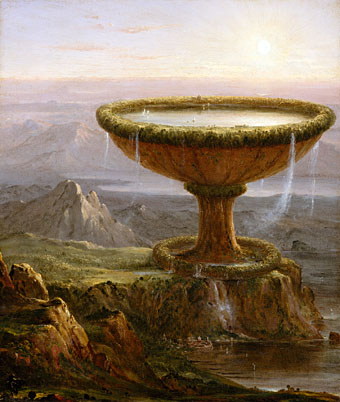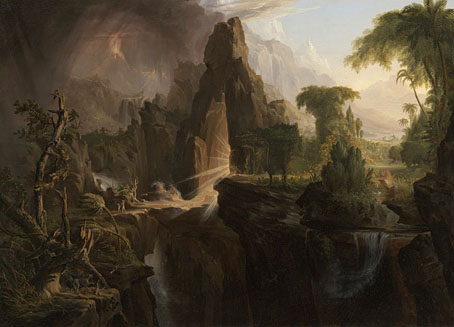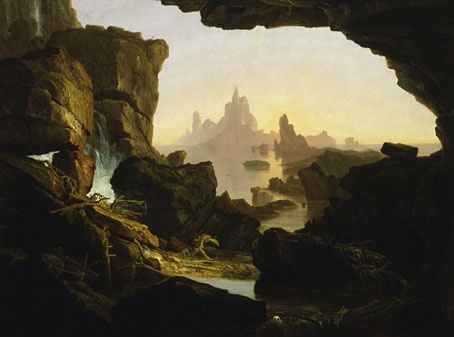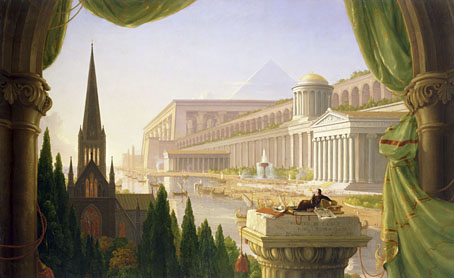The Titan’s Goblet (1833).
Thomas Cole’s Titan’s Goblet isn’t featured at the Google Art Project, unfortunately, but the following paintings are, and all benefit from being able to explore their details. Cole’s colossal vessel predates Surrealism by a century, and is one of many paintings which always has me mentally labelling him as the American John Martin (1789–1854). Having thought of him for years as an American artist–not least because he founded the Hudson River School–it’s a surprise to learn he was born in Bolton, a town not far from Manchester, with his parents emigrating to the US when he was 17. John Martin also grew up in the north of England so there’s another similarity, although the more important comparison concerns their use of painting to convey the spectacularly vast and unreal scenes common to the imaginative side of Romantic art. The Titan’s Goblet is unusual in not having any particular symbolic or moral significance, unlike the pictures below, it’s Magritte-like in its careful depiction of the impossible. The Subsiding of the Waters of the Deluge, on the other hand, could be exhibited beside Francis Danby’s The Deluge (1840) for a “before and after” effect. Like Martin, Cole enjoyed painting architecture of an exaggerated scale. The Architect’s Dream features an Egyptian temple of stupendous size, while the pyramid looming in the background is closer to William Hope Hodgson’s seven-mile-high Last Redoubt than any structure on the Nile plain.
Of equal interest are Cole’s two well-known series: The Course of Empire (1833–36) and The Voyage of Life (1842), both of which I’d love to see at Art Project size.
Expulsion from the Garden of Eden (1828).
The Subsiding of the Waters of the Deluge (1829).
The Architect’s Dream (1840).
Elsewhere on { feuilleton }
• The fantastic art archive
Previously on { feuilleton }
• John Martin’s musical afterlife
• Albert Bierstadt in Yosemite
• Danby’s Deluge
• John Martin: Heaven & Hell
• Darkness visible
• Two American paintings
• The apocalyptic art of Francis Danby





The Architect’s Dream features an Egyptian temple of stupendous size
Perhaps the architect was Albert Speer.
Speer and Hitler were more inspired by the Ancient Greeks whose temple architecture they diluted to monotony.
Interesting/slightly embarrassing that one of my favourite pieces of art is The Professor’s Dream by C R Cockerell – and I’ve never even heard of Cole or seen The Architect’s Dream (which pre-dates it) reproduced anywhere.
Yes, I know that one although I wouldn’t have been able to say who the artist was without searching around. The next post has a link to some nice details of it courtesy of BLDGBLOG. I mentally collect these kind of architectural fantasies–offhand I can think of at least one other by cartoonist Winsor McCay, one of his editorial drawings:
http://commons.wikimedia.org/wiki/File:Winsor_McCay_indian_city.png
Makes me wonder how many others there are.
I imagine you already have Aldiss and Wilks’ “Pile” in your mental collection, not to mention the splendidly pyramidal confections that feature at John Ptak’s Science Books.
http://longstreet.typepad.com/thesciencebookstore/2011/12/centennial-tower-1876.html
Come to think of it, Ptak even showed a version of “The Professor’s Dream” a few years ago, as printed in the Illustrated London News — but he didn’t explain the background.
http://longstreet.typepad.com/books/2010/11/stuff-blocking-the-horizon-christopher-wrens-buildings.html
I don’t think I’ve seen those before although the memory could be playing tricks. The history of unbuilt towers and designs for expositions is a whole other subject. There’s a nice book at the Internet Archive that shows the many designs for a London tower to rival the Eiffel Tower. I think one of them was even being built at one stage until somebody changed their mind and they demolished the foundations.
There’s a section on the unbuilt London tower in Betjemen’s Metro-Land – sited where Wembley Stadium is these days if I remember correctly.
Oh, I have the Betjeman film on tape but haven’t watched it for years. I’d forgotten about that.
The history of unbuilt towers and designs for expositions is a whole other subject.
Ptak’s blog-post about
Freyssinet’s half-mile-high lighthouse / restaurant (for the 1937 Paris Exhibition) had me scratching my head for days, wondering where I’d seen it before — until I remembered the tower’s appearance in a cartoon strip, printed in Heavy Metal back around 1980.
That’s one I don’t recall although if it was in Heavy Metal I’m sure I must have seen it. Not unlike the ridiculous “Car-Vu” parking tower in the first episode of the Captain Scarlet TV series which would have involved the same dizzying (and no doubt dangerous) corkscrew ride. There’s a picture of that here comparing it to the Seattle Space Needle which was another exposition building:
http://3.bp.blogspot.com/-qYja3e9IoxM/T9yMk3TfKNI/AAAAAAAAQ8w/Q5D3z5Q1h2w/s1600/Car+Vu+and+Space+Needle+Collage.jpg
It turned out to be “A Second Babel” by Joost Swarte, in the Nov. 1984 issue.
comparing it to the Seattle Space Needle
I am not convinced that the Seattle Tower benefits from the Lyonel Feininger / rayonist treatment.